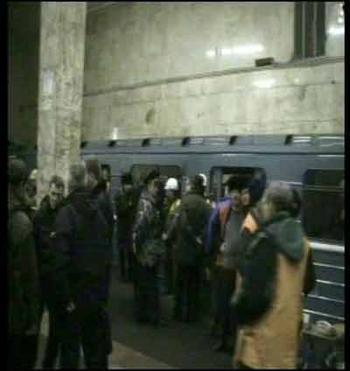Special services conceal the exact number of victims of the Metro blast
 Moscow authorities have been banned from revealing the information on the victims of the blast in the Metro, the Gazeta newspaper wrote.
Moscow authorities have been banned from revealing the information on the victims of the blast in the Metro, the Gazeta newspaper wrote.
Moscow mayor Yury Luzhkov and his deputy Valery Shantsev have the list of the killed in the blast, but “Federal Security Service prohibited to make them public because there are more dead than 39 as authorities had announced”, a source in Moscow City Hall said in a Gazeta interview.
A student who had been in the third Metro train car said to reporters that “the second car was completely destroyed, there was bloody jumble inside. After we left our car, the first thing I thought of – there were no survivors in the second car, all was motionless inside it”.
One of the doctors participating in pulling out the mortal remains of the dead passengers said that “God grant to have less than 100 dead”. In addition, plenty of bodies and remains thrown out of the train by the blast wave were lying inside the Metro tunnel.
There is also information that 30 -50 passengers of the third train car survived the explosion. Meanwhile, the car was 19.21 meters long and 2.71 m wide, and estimating its maximum load (10 people per square meter) there could be up to 330 passengers inside.
On average, there are about 2,000 – 2,300 passengers on the eight-car Metro train in the morning, Moscow Metro Administration reported.
According to the Metro employees, there are usually 200 – 250 people in one train car of the “green” line at that time of the day. The bomb was placed about one meter above the car floor. The explosion was so powerful that the blast wave speed (strongly accelerated by the car closed space) reached about 2,000 meters per second.
“There are three striking zones of the explosion calculated by the special technique”, said high-ranking official of Moscow police Leonid Bachurin in a Gazeta interview. “The nearest zone was in the radius of 2.5 meters. The people standing there were torn apart. The middle zone was in the radius of 17 – 18 meters, that is all the second car and half of the first car, about 200 – 250 passengers in total. In this zone people were hit with the blast wave and secondary fragments – the car paneling, broken hand-rails, glass. People are burned and traumatized with pressure rise – their lungs and ear-drums are torn apart.
Finally, the widest, but also the least dangerous, remote striking zone has radius about 50 – 75 meters. This zone embraced the first and the third train cars whose passengers were wounded with secondary fragments and the pressure rise, some people got contusions.
“The terrorists did not apply stuffing bomb because there was no need to increase its striking capacity under these conditions”, said Bachurin. “The bomb is stuffed with nails, metal beads and bolts for acts of terrorism in open space, in closed space this makes no sense as the blast wave becomes the primary striking force”.
Book “Road to Allah” was found in the exploded train car.
The main version of the Staturday metro blast is the act of terrorism conducted by the martyrgoing in the second train car. It is impossible to detect whether the suicide bomber was a man or a woman because he/she was torn apart and his remains mixed with those of the other people standing nearby.
One of the specialists examining the exploded car came to the conclusion that two bombs could explode there simultaneously. Video images of Avtozavodskaya Metro Station confirm this statement. The camera fixed two people of “Caucasian appearance” – a man and a woman, entering the second train car and carrying two big suitcases.
Special explosive and technical expertise will be conducted shortly after specialists of Federal Security Service and Moscow Office of Public Prosecutor finish examining the exploded car. The examination has already produced certain results. Burned book called “Road to Allah” was found among the passengers’ belongings. However, there is no proof that it belonged to the terrorist, the Kommersant wrote.
According to the Kommersant, “the investigation in Moscow will hardly produce meaningful results”. The investigation was passed over from Moscow Office of Public Prosecutor to Federal Security Service, and this demonstrates that investigation measures in the regions are the most important. First of all, in Chechnya where the organizers of all big terrorist acts are hiding, along with Ingushetia and Kabardino-Balkaria from where terrorists are being transported to the Central Russia.
Investigation Task Forces have been established in the North-Caucasian regions of Russia. One of their task is checking the Chechen families whose members or relatives were killed during the last Chechen war. Most terrorist leaders recruit suicide bombers in such families.
Except for act of terrorism, Federal Security Service has at least two more versions for the explosion. According to one of them, the bag equipped with clockwork or electronic decelerator was left by terrorists in the train car. The explosion could happen after a passenger lifted the bag (it has been detected that the fuse exploded at the height of 40 – 50 centimeters above the floor). Another version is that the explosion was accidental – a passenger could carry explosives which somehow detonated on the train.
Monday – mourning day
Moscow mayor Yury Luzhkov Monday, February 9 announced mourning day for Moscow.
Flags of Russia and Moscow with black ribbons have been set throughout the Russian capital. It is recommended to cancel all entertainment show and programs.
According to official information, 39 people died in the explosion, 23 of them have been identified. 134 people were treated by doctors.
According to Moscow Health Care Committee, now 107 victims of the explosions are hospitalized. 29 of them are in critical condition, 44 – in bad condition, 9 were released from hospitals. The most common medical diagnosis for the victims are burns of respiratory tract, face and hands.
Source: Gazeta, NEWsru, RIA-Novosti, Izvestia
Subscribe to Pravda.Ru Telegram channel, Facebook, RSS!




